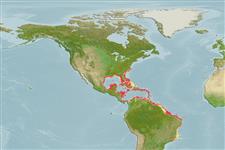>
Eupercaria/misc (Various families in series Eupercaria) >
Haemulidae (Grunts) > Haemulinae
Etymology: Haemulon: Greek, haimaleos = bloody (Ref. 45335).
Eponymy: Charles Plumier (1646–1704) was a Franciscan monk, botanist and naturalist. [...] (Ref. 128868), visit book page.
More on author: Lacepède.
Environment: milieu / climate zone / depth range / distribution range
Écologie
marin récifal; profondeur 3 - 40 m (Ref. 9626). Subtropical; 39°N - 23°S, 99°W - 30°W
Western Atlantic: Chesapeake Bay, through the Gulf of Mexico and Caribbean southward to Brazil. Including Antilles (Ref. 26938).
Length at first maturity / Taille / Poids / Âge
Maturity: Lm 18.3, range 11 - 23.23 cm
Max length : 53.0 cm TL mâle / non sexé; (Ref. 40637); common length : 30.0 cm TL mâle / non sexé; (Ref. 3798); poids max. publié: 4.4 kg (Ref. 4699)
Épines dorsales (Total) : 12; Rayons mous dorsaux (Total) : 17; Épines anales: 3; Rayons mous anaux: 9. Side of head has narrow blue stripes; scales above lateral line much larger than those below (Ref. 26938). Scale rows just below lateral line oblique; color variable but usually light yellowish (Ref. 13442).
Found in dense aggregations during the day on patch reefs, around coral formations, or on sandy bottoms (Ref. 9710). Juveniles common in Thalassia testudinum beds (Ref. 5217). Feeds on crustaceans, small mollusks, and small fishes. Frequently exhibits a territorial 'kissing' display in which two contenders push each other on the lips with their mouths wide open (Ref. 9710). Marketed fresh. Has been reared in captivity (Ref. 35420).
Oviparous, distinct pairing during breeding (Ref. 205).
Courtenay, W.R. and H.F. Sahlman, 1978. Pomadasyidae. In W. Fischer (ed.) FAO species identification sheets for fishery purposes. Western Central Atlantic (Fishing Area 31), Volume 4. FAO, Rome. (Ref. 3798)
Statut dans la liste rouge de l'IUCN (Ref. 130435: Version 2024-1)
Menace pour l'homme
Reports of ciguatera poisoning (Ref. 30303)
Utilisations par l'homme
Pêcheries: intérêt commercial mineur; pêche sportive: oui; Aquarium: Aquariums publics
Outils
Articles particuliers
Télécharger en XML
Sources Internet
Estimates based on models
Preferred temperature (Ref.
123201): 23.4 - 28, mean 25.9 °C (based on 342 cells).
Phylogenetic diversity index (Ref.
82804): PD
50 = 0.5000 [Uniqueness, from 0.5 = low to 2.0 = high].
Bayesian length-weight: a=0.01413 (0.01172 - 0.01703), b=2.99 (2.95 - 3.03), in cm total length, based on LWR estimates for this species (Ref.
93245).
Niveau trophique (Ref.
69278): 3.8 ±0.0 se; based on diet studies.
Generation time: 3.5 (3.1 - 7.0) years. Estimated as median ln(3)/K based on 11
growth studies.
Résilience (Ref.
120179): Milieu, temps minimum de doublement de population : 1,4 à 4,4 années (K=0.16-0.35; tm=2; tmax=13; Fec=64,000).
Fishing Vulnerability (Ref.
59153): High vulnerability (62 of 100).
Nutrients (Ref.
124155): Calcium = 18.3 [6.7, 44.4] mg/100g; Iron = 0.473 [0.231, 0.908] mg/100g; Protein = 20 [18, 22] %; Omega3 = 0.187 [0.092, 0.339] g/100g; Selenium = 14.4 [6.7, 29.7] μg/100g; VitaminA = 57.2 [19.6, 171.8] μg/100g; Zinc = 0.754 [0.474, 1.170] mg/100g (wet weight);
